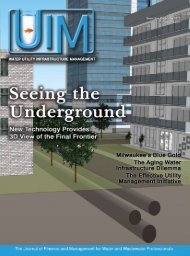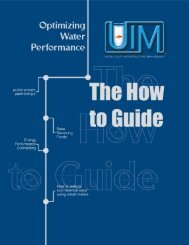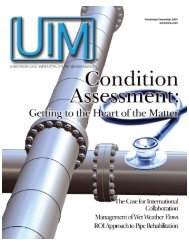Download - Water Utility Infrastructure Management
Download - Water Utility Infrastructure Management
Download - Water Utility Infrastructure Management
Create successful ePaper yourself
Turn your PDF publications into a flip-book with our unique Google optimized e-Paper software.
Protective Coating<br />
for Wastewater<br />
Facility Concrete<br />
Surfaces —<br />
Best Practices<br />
Coatings can be an efficient and cost-effective<br />
technical solution for protecting and renewing<br />
sanitary sewer tanks, pipelines and appurtenances.<br />
Asset management principles and practices<br />
require wastewater utilities to look beyond the initial<br />
cost and focus more on long-term solutions and lower<br />
life-cycle costs. Premature failures of coatings have generated<br />
much concern regarding true life-cycle costs.<br />
Concrete coating systems for wastewater service must<br />
typically withstand immersion, harsh chemicals, abrasion,<br />
low pH and other challenging conditions. Premature<br />
coating failure is significantly higher with concrete than<br />
with steel, for example, due to several additional variables<br />
including moisture content, surface strength, surface<br />
irregularity, alkalinity, composition and porosity,<br />
which results in a difficult surface to effectively coat and<br />
protect. Other factors include surface preparation and<br />
coating system mixing, application and curing practices,<br />
to name only a few.<br />
Some of the most common concrete coating system<br />
defects and failure mechanisms in wastewater applications<br />
are:<br />
• Osmotic blistering<br />
• Pinholes and voids<br />
• Peeling<br />
These failures or defects will typically lead to premature<br />
concrete damage, compromising structure integrity<br />
and personnel safety and necessitating costly repair and<br />
premature infrastructure replacement.<br />
Many concrete coating products for wastewater service<br />
exist in the marketplace and new products are entering<br />
the market frequently. This paper provides a review of the<br />
importance of product and process validation and presents<br />
recommendations and lessons learned in specifying,<br />
applying and utilizing these products over the past 20<br />
years.<br />
By Jeff Maxcy and Tom Iseley<br />
Product Evaluation and Validation<br />
Product evaluation and validation is not a new concept,<br />
and has been demonstrated to be an important factor in<br />
achieving success. It provides the benefit of using materials<br />
that have already proven to be effective in similar<br />
applications.<br />
Owner representatives and consulting engineers have<br />
for many years realized the importance of reviewing new<br />
products and processes. Most of the larger utilities with<br />
support from consultants have developed product review<br />
committees (PRCs). However, small- to medium-size utilities<br />
tend to have no formal process. Even for utilities with<br />
PRCs, the review, validation and acceptance/rejection<br />
tend to vary significantly from agency to agency. Often<br />
this process is time-consuming, awkward, inconsistent,<br />
subject to political influence and expensive. This wide<br />
variance in how decisions are made to accept/reject products<br />
and processes results in major challenges and<br />
expense for the technical solution providers.<br />
In 2009, the City of Indianapolis and the Construction<br />
Engineering <strong>Management</strong> Technology (CEMT) program<br />
at the Purdue School of Engineering and Technology at<br />
IUPUI entered into a collaborative agreement that resulted<br />
in development of a 10-step new product review process.<br />
To date, more than 15 products have been evaluated<br />
through this innovative process at no expense to the City.<br />
The technology providers pay a fee. This program has<br />
been very successful. During 2010, both Fort Wayne, Ind.,<br />
and Zionsville, Ind., have entered into similar agreements<br />
with the university.<br />
Due to the strong interest in the new product review<br />
process from utilities and consultants across the nation, a<br />
new program will be launched to provide access to all new<br />
product review reports on a subscription basis. The nonprofit<br />
Institute of Product Validation (IPV) (www.institutepv.com)<br />
has been formed to manage the national<br />
program. Any utility or industry representative can subscribe<br />
to the IPV services and access the new product<br />
36 <strong>Water</strong> <strong>Utility</strong> <strong>Infrastructure</strong> <strong>Management</strong><br />
November/December 2011








